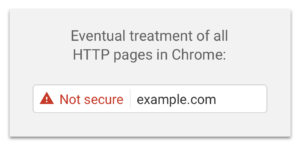As a child care center, parents trust you to keep their kids safe and help them grow, from infancy to school-age. Building this trust starts as soon as a parent lands on your website. One of the fastest ways to damage the relationship with a parent is with a large “Not Secure” warning at the top of their web browser.
With this warning, Google Chrome is alerting website visitors that your website uses HTTP instead of HTTPS. Beginning in October 2018, all websites without HTTPS will be marked with a “Not Secure” warning. When a parent tries to enter data on your website, this warning will turn red.

Parents who use Safari, Firefox and Internet Explorer (as well as other browsers) also see warnings when visiting an unsecured website. However, when a website uses HTTPS, Chrome displays a padlock to the left of the URL to let parents know their information is safe. This is also true of other browsers, like Safari.
What is HTTPS?
HTTPS is short for HyperText Transfer Protocol Secure. It’s the S at the end that’s so important. When your website uses HTTPS (instead of just HTTP), the information parents submit to your website is protected. Without this S, the data submitted to your website (like names, addresses, children’s ages and more) is vulnerable to attacks and can be stolen.
To change your website from HTTP (unsecure) to HTTPS (secure), you need to use an SSL certificate.
How does SSL work?
An SSL certificate is what provides secure encryption. It works as a “key” or a “handshake” between a parent looking at your website and the website itself. Each key is unique, so your website is always secure and everyone who visits it is protected. With an SSL certificate, parents who submit information to your website can do so securely. This is a great way to let parents know your center is trustworthy before they step through the door!


